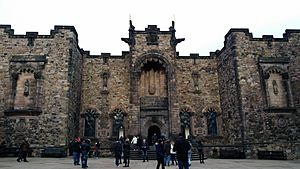Hazel Armour facts for kids
Quick facts for kids
Hazel Ruthven Armour
|
|
|---|---|
| Born | 15 October 1894 Edinburgh, Scotland
|
| Died | 1985 (aged 90–91) Aldeburgh, Suffolk, England
|
| Education | Edinburgh College of Art |
| Known for | Sculptor |
Hazel Ruthven Armour (born October 15, 1894 – died 1985) was a talented Scottish artist. She was famous for creating sculptures and medals.
Contents
Early Life and Art School
Hazel Armour was born in Edinburgh, Scotland. She was the second daughter of Harry and Mollie Armour. She first learned at home. Later, she went to the Edinburgh College of Art. She studied there until 1915. She then attended more regularly. She earned a Diploma in 1917. She also got a Post-Graduate Diploma in 1918. After that, she continued her art studies in Paris, France.
Her Work as a Sculptor
After marrying John Kennedy in 1921, Hazel Armour kept art studios in both Edinburgh and London. She became well-known for her sculptures and medals. Her work was shown at important art exhibitions. These included the Royal Scottish Academy in 1914. She also exhibited at the Royal Academy in London in 1916. In 1917, her art was displayed at the Royal Glasgow Institute of the Fine Arts.
Hazel Armour worked on the Scottish National War Memorial. This was a very important project. She collaborated with other artists like Phyllis Mary Bone and Gertrude Alice Meredith Williams. Around 1927, she helped finish the Chaplains' memorial section. She also made a special medal. This medal was for the Scottish Women's Hospital at Royaumont from the First World War.
In 1931, she joined the Society of Scottish Artists. Two years later, in 1933, she started the Edinburgh Mothers' Welfare Clinic. She was the chairperson there. In 1938, an accident affected her husband's health. This made it harder for Armour to work as much. However, she still spent time in London. She created models of famous people from the theater world. These included actor Paul Scofield and actress Edith Evans. She also sculpted Leslie Hurry, a painter and set designer. A sculpture of Leslie Hurry's head was shown in a book about British sculpture in 1947.
African Journeys and Art
During the 1920s and 1930s, Hazel Armour traveled to South Africa twice. These trips greatly influenced her artwork. She created many sculptures inspired by the people she met there. These sculptures were heads of African sitters. She carved them from wood and stone. Some were made from clay and later cast in bronze. Her work was also part of the Empire Exhibition in Scotland in 1938.
Later Life and Legacy
Hazel Armour's husband passed away in 1966. After his death, she lived in London. Later, she moved to Aldeburgh, where she died in 1985. Sadly, a fire in her studio destroyed many of her artworks.
Her work was featured in a special exhibition. It was called Modern Scottish Women: Painters and Sculptors 1885-1965. This exhibition took place at the Scottish National Gallery of Modern Art. It ran from November 2015 to June 2016. Her art was shown alongside 45 other talented Scottish female artists.


